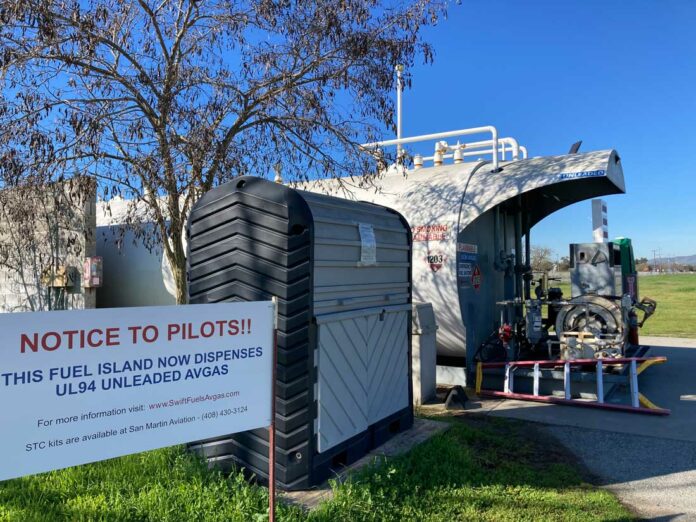
Leaded aviation fuel is no longer available for sale at San Martin Airport and Reid-Hillview Airport in east San Jose after a Santa Clara County ban on the gas, commonly known as 100LL, at the sites went into effect Jan. 1.
But federal authorities are investigating the county’s action, and pilots who use the airports wonder if the timing of the local leaded fuel prohibition will accomplish its health-promoting objectives.
The county Board of Supervisors voted in August to stop leaded fuel sales, following the release of a peer-reviewed study that statistically linked ongoing use of leaded aviation gas with elevated lead exposure for the 13,000 children living near Reid-Hillview Airport, county staff said. No such study has been conducted relative to the San Martin Airport.
As of Jan. 1, only unleaded fuel is available for sale at San Martin and Reid-Hillview airports. Aircraft that use leaded fuel can still fly into and out of the two airports.
In response to the county’s order, the San Martin Airport eliminated leaded fuel sales at the Murphy Avenue facility just before the end of 2021, said Daniel Neal, President of San Martin Aviation Corp., which contracts with the county to operate the local airport.
A large sign at the only fuel pump at the San Martin Airport alerts pilots that only UL94, or unleaded gas, is available at the site. The airport has a mobile jet fuel tank that also dispenses unleaded fuel.
County staff said the San Martin Airport dispenses about 40,000 gallons of jet fuel annually.
Neal said between 60-75 aircraft, or about half the planes, that currently lease space at the San Martin airport cannot operate on unleaded fuel. These pilots must purchase leaded fuel elsewhere—such as the Hollister airport—and then fly back to San Martin to get home.
Two other airports in Santa Clara County—San Jose Mineta and Palo Alto Airport—continue to sell 100 octane leaded avgas, or 100LL, which is commonly used by piston-powered airplanes.
Neal added that he expects fuel sales to drop by about 90% at the San Martin Airport without 100LL allowed in the pumps. That revenue is a big chunk of San Martin Aviation Corp.’s business plan, and Neal said he may be forced to try to renegotiate his contract with the county.
Neal and other pilots say they support efforts to remove poisonous lead from the atmosphere, but they don’t think the county’s plan to get there is supported by the evidence. The study commissioned by the county last year was not as conclusive as county officials and environmentalists have claimed, Neal said.
“We didn’t think they would step it up at this pace,” Neal said of the county’s ban on 100LL at the two airports. “It’s good to get lead out of the fuel, but its replacement is early at this stage.”
And despite the U.S. Environmental Protection Agency’s declaration alongside county officials last week that it will look into curbing the use of leaded aviation fuel nationwide, another federal agency is investigating the county’s prohibition of 100LL in San Martin and east San Jose.
The Federal Aviation Administration on Dec. 22 sent a letter to the Santa Clara County Airports Administration notifying local officials of the FAA’s concerns. The letter, which was posted publicly by the pilots association known as AOPA, stated that the FAA had received “multiple complaints” from airport tenants and users “who alleged violations of grant assurances at the Reid-Hillview Airport and the San Martin Airport.”
The county’s prohibition of leaded fuel sales, terminations of leases and unspecified safety concerns may have violated the terms of FAA grant funding received by the two airports, the letter from Mark A. McClardy of the FAA said.
The San Martin Airport has benefited from about $4.6 million in federal funding from 1984 to 2021, McClardy’s letter states. Reid-Hillview received about $6.8 million from the feds between 1983-2011.
“The FAA is committed to building a sustainable aviation system and a lead-free future, and the agency will work with the County to achieve this shared goal,” says the Dec. 22 letter. “However, in the interim, all parties must adhere to grant assurances. Therefore, the FAA strongly recommends that the County take action to suspend the effective date of its ban on leaded gas at the County-owned airports until this matter can be resolved.”
An FAA spokesperson declined to comment further this week because of the “ongoing investigation.”
The adverse health effects of lead—particularly in children—are well known, significant and concerning, county staff noted. The county-commissioned study found that if leaded emissions (and the related adverse impact on IQ and cognition) ended, children living near Reid-Hillview Airport would realize a gain of $11 million to $25 million in lifetime earnings.
Reid-Hillview and San Martin are likely the first airports in the U.S. to halt the availability of 100LL.
On Jan. 12, the EPA announced that it will grant a petition by the county and environmental groups to eliminate lead pollution from aircraft throughout the nation, says a press release from the county. The EPA committed to completing an “endangerment finding” on leaded aviation gas by 2023, which could lead to a nationwide ban on the fuel.
While county officials celebrated the EPA’s action, they cautioned it will take years to complete the regulatory process.
“There are airports all across the nation subjecting children to poisonous fumes every day,” Supervisor Cindy Chavez said. “It’s a known fact and a serious problem, and past time to really take steps toward fixing it.”
County officials have wanted to close Reid-Hillview Airport for several years due to declining revenue and safety concerns. In 2018, the county stopped applying for FAA funding for Reid-Hillview, and in November 2020 the board of supervisors voted on a plan to redevelop the airport site for affordable housing and mixed use.














